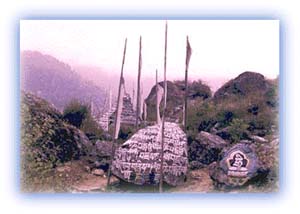Nepal Himalayas
General Info
· Solo Khumbu
· Namche Bazar
· Thyangboche
· Pangboche
· Kalapattar
· Pheriche
· Buddhism in Khumbu
· Mount Everest
· The Quest for Everest
· Early Years
· The 1950s
· Sherpas on Everest
· Central Nepal
· Mustang
· Jomsom
· People: Thakalis
· Muktinath
· Manang valley
· Bryagu village
· Manang village
· Nyasang Division
· Western Nepal
· Jumla
· Sukhadik
Photo Feature:
· Annapurna region
High Altitude Sickness
Endangered Species
Protected Areas
Yaks
The Yeti Factor

![]()
|
Sherpas - page 2 Also read the previous page The first notable and successful Sherpa climber is Tenzing Norgay. In 1952, Norgay accompanied Raymond Lambert on a Swiss expedition which reached very close to the summit of Mt Everest. Norgay returned the next year with the British Expedition of 1953, and along with Edmund Hillary of New Zealand became the first man to reach on the highest point on earth. There was no looking back. Sherpas have embraced mountaineering in a large way ever since. Mountaineering institutes in Darjeeling (India) and other places have engaged them as trainers. In the early years, the fantastic achievements of the Sherpas were only recorded as footnotes in the annals of mountaineering history. But in recent years, the Sherpas have been given their rightful credit. Ang Rita Sherpa is among the most well-known Sherpas, with an astounding record of having reached the top of Mt Everest ten times. In 1993 Pasang Lhamu Sherpa became the first Sherpa woman of Nepal to reach the top of Mt Everest. Unfortunately, she died on her way back. |
 |
| Pasang Lhamu. Credit: Mahabir Pun |
The traditional food of the Sherpas is derived from high- altitude crops such as potatoes, barley and buckwheat. Nepali foods like dal (lentils), rice, and Tibetan Tsampa form the staple Sherpa diet. Much of the trading between the lowland Nepalis and the Tibetan peoples of the mountains now take place at markets such as the one in Namche Bazar. Namche lies on the traditional trade route with Tibet and has been used for centuries by traders, who would bring down yaks, salt and dried sheep meat from Tibet and return with goods from India such as rice, corn and millet. Along with food, jewelry is often traded at bazaars.
 |
| Prayer flags and stones marked with the Tibetan mantra Om mani padme hum -- mani stones. Credit: Scott Yost |
The Sherpas have received support from the Westerners that they look after so well in the mountains. Western funding helps run a variety of projects in the Khumbu area, including schools, medical facilities and ecological programs.
The Sherpa religion is a mixture of Buddhist traditions and animistic faith. The culture has evolved from centuries of myths, legends and the strong influence of religion. The name Khumbu comes the guardian deity Khumbila Tetsan Gelbu which, literally translated, means "Khumbu country god".
All rights reserved